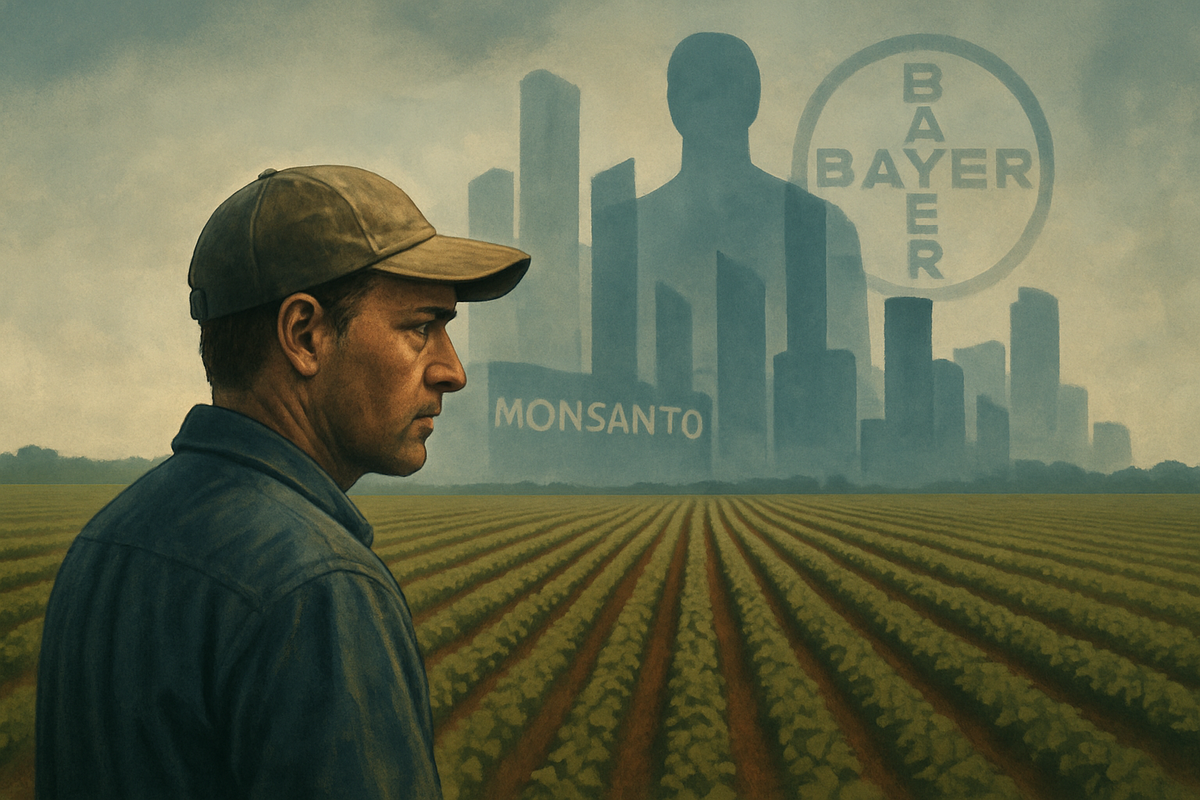
U.S. lawmakers are increasingly vocal about the escalating consolidation within the seed and fertilizer industries, warning that a dwindling number of dominant players poses a severe threat to the agricultural sector. Concerns are mounting over potential anti-competitive practices, which are driving up essential input costs for farmers and could ultimately lead to higher food prices for consumers. This intensifying scrutiny comes amidst a backdrop of shrinking farm margins and a growing dependence on a few multinational corporations for critical agricultural supplies.
The immediate implications are stark: farmers are facing what many describe as a "crisis" of soaring production costs, with seed and fertilizer prices climbing dramatically since 2020. This economic squeeze threatens the viability of family farms, limits farmer choice, and could have a ripple effect across the entire food supply chain, impacting the financial stability of the agricultural industry and the wallets of everyday Americans.
Congressional Scrutiny Intensifies Over Agricultural Monopolies
The growing apprehension among U.S. lawmakers regarding consolidation in the seed and fertilizer industries has reached a fever pitch, culminating in recent Senate Judiciary Committee hearings that brought these issues to the forefront. These hearings have served as a platform for farmers, independent seed companies, and agricultural economists to voice their concerns over what they describe as a failure of antitrust regulators to adequately address excessive market concentration.
The timeline of this consolidation can be traced back years, with a series of major mergers reducing the "Big 6" agricultural giants to effectively four dominant players: Bayer AG (ETR: BAYN), Corteva, Inc. (NYSE: CTVA), Syngenta Group (SHA: 600000), and BASF SE (ETR: BAS). These companies now control vast swathes of the market, with just two firms commanding at least 72-73% of the U.S. corn seed market and two-thirds of soybean seeds. Similarly, four firms dominate virtually all of the phosphate and potash markets, alongside a significant share of nitrogen fertilizer. This concentrated market power has led to allegations of anti-competitive practices, including loyalty rebate programs that stifle smaller competitors and rising licensing fees for seeds, even without significant new innovations.
Key players involved in this debate extend beyond the major corporations to include influential lawmakers like Senator Chuck Grassley (R-Iowa), who has been a vocal critic of the lack of transparency in fertilizer markets and has proposed the "Fertilizer Research Act" to mandate USDA studies on competition and pricing. The U.S. Department of Agriculture (USDA) and the Department of Justice (DOJ) have also entered the fray, launching a joint antitrust probe into agribusiness, including seed and fertilizer suppliers, to investigate potential antitrust violations. Initial reactions from the agricultural community have been a mix of relief that their concerns are finally being heard, coupled with a persistent demand for concrete legislative and regulatory action to restore competition and fairness to the market.
Who Stands to Win and Lose in a Consolidated Market
The landscape of the seed and fertilizer industries, shaped by decades of consolidation, presents a clear delineation of potential winners and losers. At the forefront of the beneficiaries are the dominant multinational corporations that have successfully acquired or merged with competitors. Companies such as Bayer AG (ETR: BAYN), through its acquisition of Monsanto, and Corteva, Inc. (NYSE: CTVA), a spin-off of DowDuPont, have cemented their positions, controlling significant market shares in seeds and agricultural chemicals. These firms benefit from economies of scale, extensive patent portfolios, and the ability to bundle products (seeds, fertilizers, and pesticides), effectively creating an ecosystem where farmers become reliant on their integrated solutions. Their market power allows them to dictate pricing, often leading to increased revenue and profitability, even as farmers' margins shrink. Similarly, Syngenta Group (SHA: 600000) and BASF SE (ETR: BAS) hold substantial sway in the fertilizer and crop protection sectors, leveraging their global reach and research capabilities to maintain competitive advantages.
Conversely, the primary losers in this consolidated environment are independent seed companies and, most significantly, the individual farmers. Independent seed companies struggle to compete against the vast resources and market access of the giants. They face challenges in obtaining competitive licensing terms for foundational seed genetics, are often outbid in acquisitions, and find it difficult to scale their operations to offer a diverse range of products at competitive prices. Many are forced to either specialize in niche markets or eventually sell out to larger entities. For farmers, the impact is more direct and financially crippling. They face limited choices for essential inputs, leading to dependency on a few suppliers. This lack of competition translates directly into higher prices for seeds and fertilizers, which have seen increases of 18% and 37% respectively since 2020. With agricultural commodity prices fluctuating and often falling (reportedly down 50% since 2022), the soaring input costs are eroding farmer profitability, threatening the sustainability of family farms, and potentially leading to widespread farm closures. The lack of transparency in pricing, particularly for fertilizers, further exacerbates their disadvantage, making it difficult for farmers to negotiate or find fair deals.
Broader Implications and Historical Parallels
The current concerns over consolidation in the seed and fertilizer industries are not isolated incidents but rather fit into a broader trend of increasing market concentration across various sectors of the U.S. economy. This phenomenon is particularly acute in agriculture, where a series of mega-mergers over the past two decades has drastically reshaped the competitive landscape. The drive for efficiency, global reach, and control over intellectual property has fueled this consolidation, with companies aiming to offer "total solutions" to farmers, from genetic seeds to crop protection and nutrition. This integration, while potentially offering some benefits in terms of research and development, raises serious questions about market power and its impact on smaller players and consumers.
The potential ripple effects of this consolidation are far-reaching. For competitors, particularly smaller and mid-sized agribusinesses, the environment becomes increasingly challenging, leading to either acquisition, specialization, or exit from the market. Partners, such as agricultural distributors and retailers, may find their bargaining power diminished as they deal with fewer, larger suppliers. Regulatory and policy implications are significant, with calls for stricter antitrust enforcement from the Department of Justice and the Federal Trade Commission. Lawmakers are also exploring legislative avenues, such as Senator Grassley's proposed "Fertilizer Research Act," to increase transparency and investigate anti-competitive practices. Historically, periods of intense industry consolidation have often led to public outcry and subsequent regulatory interventions, as seen in the railroad and oil trusts of the late 19th and early 20th centuries. More recently, concerns in the meatpacking industry have drawn similar parallels, demonstrating that unchecked market power in critical sectors can lead to detrimental outcomes for producers and consumers alike. The current situation in seed and fertilizer echoes these historical precedents, underscoring the potential for market failures if left unaddressed.
The Path Forward: Scenarios and Strategic Responses
The unfolding concerns surrounding consolidation in the seed and fertilizer industries present a critical juncture for the agricultural sector, with several potential scenarios emerging in the short and long term. In the immediate future, we can anticipate intensified pressure on regulatory bodies to act. The joint antitrust probe by the USDA and DOJ is likely to accelerate, potentially leading to investigations, enforcement actions, or even divestitures if anti-competitive behaviors are proven. Lawmakers will continue to push for legislative solutions aimed at increasing market transparency and fostering competition, such as proposals for enhanced data collection on fertilizer pricing and supply chains. Farmers, facing continued high input costs, will likely explore strategic pivots, including diversifying crop rotations, adopting more sustainable farming practices that reduce reliance on synthetic inputs, or forming stronger cooperatives to enhance their collective bargaining power.
Looking further ahead, the long-term possibilities are diverse. One scenario involves successful regulatory intervention leading to a more balanced market, where independent companies can thrive, and farmers have genuine choices at fair prices. This could involve stricter merger reviews, break-ups of existing monopolies, or the establishment of robust oversight mechanisms. Another scenario, however, is that regulatory efforts prove insufficient, allowing the dominant players to further entrench their market power. In this case, we could see continued erosion of farmer profitability, a decline in agricultural innovation from independent sources, and potentially a structural shift in food production towards larger, more industrialized operations. Market opportunities may emerge for companies specializing in alternative fertilizers, precision agriculture technologies that optimize input usage, or localized seed development catering to specific regional needs. Challenges will persist for traditional agricultural input suppliers who fail to adapt to a potentially shifting regulatory and competitive landscape. The outcome will largely depend on the political will to enforce existing antitrust laws and enact new policies that prioritize competition and farmer welfare over corporate consolidation.
A Critical Juncture for Agricultural Markets
The growing alarm among U.S. lawmakers regarding the consolidation in the seed and fertilizer industries marks a critical juncture for the nation's agricultural markets. The core takeaway is clear: unchecked market concentration in these vital sectors poses a significant threat to the economic viability of farmers, the competitiveness of the broader agricultural industry, and ultimately, the affordability and security of the food supply. The research highlights that a handful of dominant corporations now wield immense power, leading to accusations of anti-competitive practices, limited choices for farmers, and dramatically escalating input costs that are squeezing farm margins to unsustainable levels.
Moving forward, the market faces a period of heightened uncertainty and potential transformation. The ongoing antitrust probe by the USDA and DOJ, coupled with legislative initiatives like Senator Grassley's proposed "Fertilizer Research Act," signals a serious intent to address these issues. However, the effectiveness of these measures remains to be seen. Investors should closely watch for concrete regulatory actions, including potential enforcement proceedings, new policies promoting market transparency, and any shifts in merger review standards. The resilience of independent agricultural businesses and the financial health of individual farmers will be key indicators of whether these efforts are succeeding.
The lasting impact of this period could be profound, potentially reshaping how agricultural inputs are produced, distributed, and priced. It underscores the delicate balance between corporate efficiency and market competition, a balance that lawmakers are now actively seeking to restore. What investors should watch for in the coming months are not just the pronouncements from Washington, but the tangible effects on input prices, the emergence of new competitive players or technologies, and the overall financial health reports from both the large agricultural conglomerates and the farming community itself. The future of American agriculture, and indeed, the dinner tables of its citizens, hinges on the outcome of this intensifying debate.
This content is intended for informational purposes only and is not financial advice





